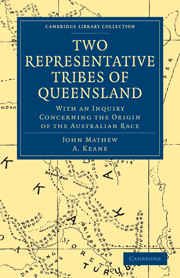 Two Representative Tribes of Queensland
Two Representative Tribes of Queensland Book contents
- Frontmatter
- Contents
- LIST OF ILLUSTRATIONS
- INTRODUCTION
- PREFACE
- CHAP. I INQUIRY CONCERNING THE ORIGIN OF THE AUSTRALIAN RACE
- CHAP. II THE COUNTRY OF THE KABI AND WAKKA TRIBES
- CHAP. III PHYSICAL AND MENTAL CHARACTERS
- CHAP. IV DAILY LIFE—SHELTER—FOOD—CLOTHING
- CHAP. V MAN-MAKING AND OTHER CEREMONIES
- CHAP. VI DISEASE AND TREATMENT—DEATH—BURIAL AND MOURNING
- CHAP. VII ART—IMPLEMENTS—UTENSILS—WEAPONS—CORROBOREES
- CHAP. VIII SOCIAL ORGANISATION
- CHAP. IX THE FAMILY—KINSHIP AND MARRIAGE
- CHAP. X RELIGION AND MAGIC
- CHAP. XI MYTHS AND LEGENDS
- CHAP. XII LANGUAGE
- VOCABULARY
CHAP. II - THE COUNTRY OF THE KABI AND WAKKA TRIBES
Published online by Cambridge University Press: 29 August 2010
- Frontmatter
- Contents
- LIST OF ILLUSTRATIONS
- INTRODUCTION
- PREFACE
- CHAP. I INQUIRY CONCERNING THE ORIGIN OF THE AUSTRALIAN RACE
- CHAP. II THE COUNTRY OF THE KABI AND WAKKA TRIBES
- CHAP. III PHYSICAL AND MENTAL CHARACTERS
- CHAP. IV DAILY LIFE—SHELTER—FOOD—CLOTHING
- CHAP. V MAN-MAKING AND OTHER CEREMONIES
- CHAP. VI DISEASE AND TREATMENT—DEATH—BURIAL AND MOURNING
- CHAP. VII ART—IMPLEMENTS—UTENSILS—WEAPONS—CORROBOREES
- CHAP. VIII SOCIAL ORGANISATION
- CHAP. IX THE FAMILY—KINSHIP AND MARRIAGE
- CHAP. X RELIGION AND MAGIC
- CHAP. XI MYTHS AND LEGENDS
- CHAP. XII LANGUAGE
- VOCABULARY
Summary
As is the case with nearly all the tribes in the east and south-east of Australia, the Kabi and Wakka tribes are so named from negatives in the respective dialects. The reason for this mode of nomenclature appears to be the fact that these negatives, by their frequent repetition, are more conspicuous to members of alien tribes than any other words. The Kabi people employ other negatives as well, viz., wa and bar, but kabi is distinctive of them.
The territory of the Kabi coincided approximately with the basin of the Mary River but extended along the coast beyond that basin both to the north and the south. Its coast-line extended from near the 27th parallel northward to about the mouth of the Burrum River, a distance of some 175 miles; measured across the land, the distance from point to point would be about 130 miles. The maximum width, measured westward from Double Island Point, is 85 miles. In addition to the mainland, there was Fraser or Great Sandy Island, about 85 miles long with an average breadth of 12 miles, so that the Kabi country altogether had an area of about 8200 square miles. I was informed by the blacks that at one time it embraced the whole of the bunya country. If this were the case, encroachments had been made by neighbouring tribes on the west and south-west.
- Type
- Chapter
- Information
- Two Representative Tribes of QueenslandWith an Inquiry Concerning the Origin of the Australian Race, pp. 67 - 71Publisher: Cambridge University PressPrint publication year: 2010First published in: 1910


